Our solar system is home to eight planets, several dwarf planets, and hundreds of moons. But, so far, we only know of one world that is friendly to life ? Earth. As we explore our family of planets, astronomers are finding oceans, organic materials, and worlds brimming with energy. Here on our planet, these conditions combine to form life. So, might we find life elsewhere in the solar system?
Astrobiologist Laurie Barge and her team at NASA?s Jet Propulsion Laboratory conducted tests mimicking the chemistry of the ancient oceans of Earth, attempting to understand how life may have started on our own world. This research could help researchers better understand how life may have started on the water worlds of our solar system.
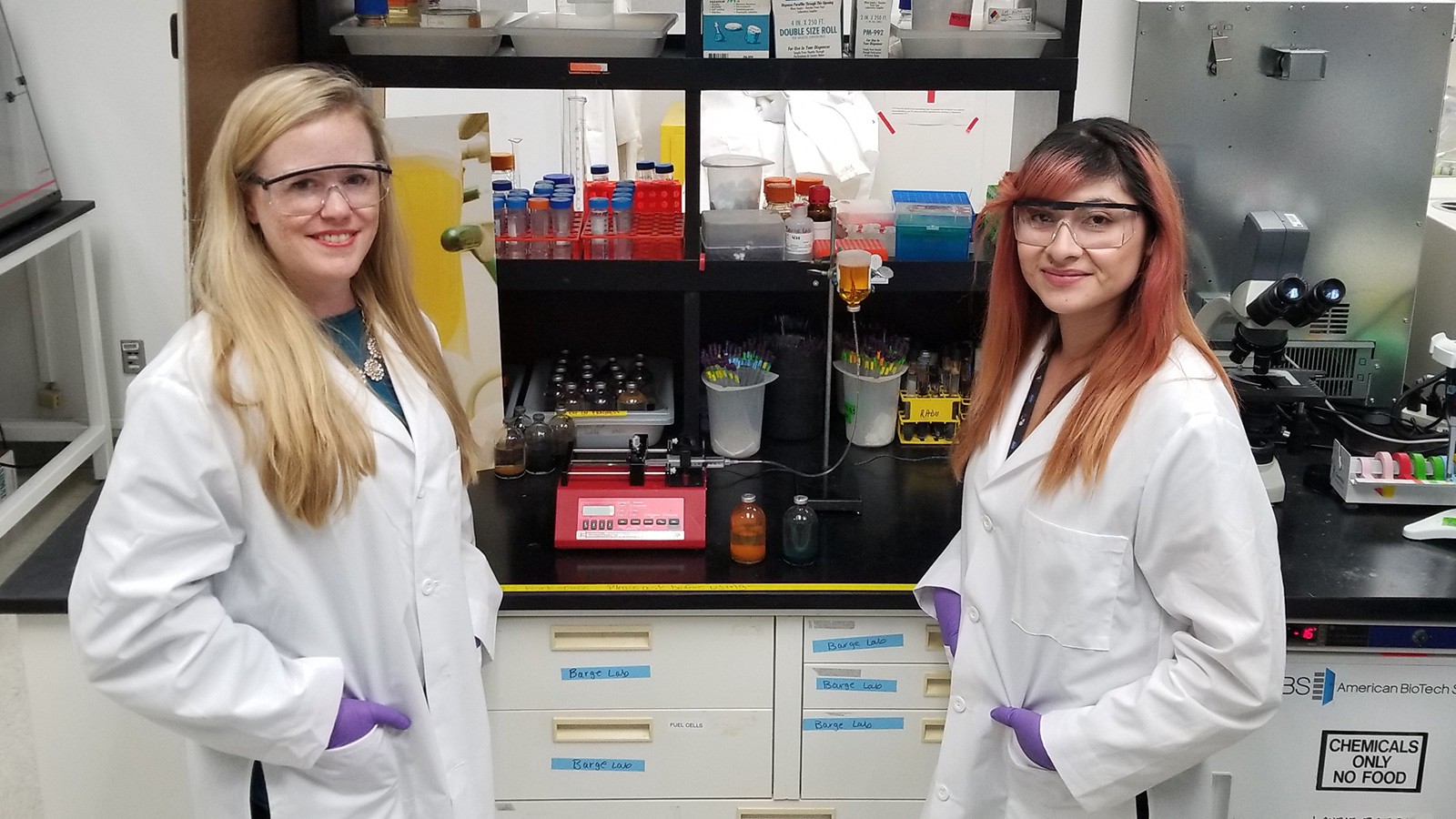 Laurie Barge (left) and Erika Flores (right) in the Origins and Habitability Lab at Jet Propulsion Laboratory. Image credit: NASA/JPL
Laurie Barge (left) and Erika Flores (right) in the Origins and Habitability Lab at Jet Propulsion Laboratory. Image credit: NASA/JPL
?Understanding how far you can go with just organics and minerals before you have an actual cell is really important for understanding what types of environments life could emerge from. Also, investigating how things like the atmosphere, the ocean and the minerals in the vents all impact this can help you understand how likely this is to have occurred on another planet,? explained Barge.
Oceans were once thought to be unique to Earth, but now we know that water is found in several locations around our family of planets. Although we know little of the nature of living beings on other worlds, water could be a beacon, guiding us to find extraterrestrial life.
Examining the water worlds of the solar system. Credit: NASA
Here is a look at the top 10 most likely places to find life in our solar system, the local water worlds (and one really cool carbon world!).
# 1: Europa
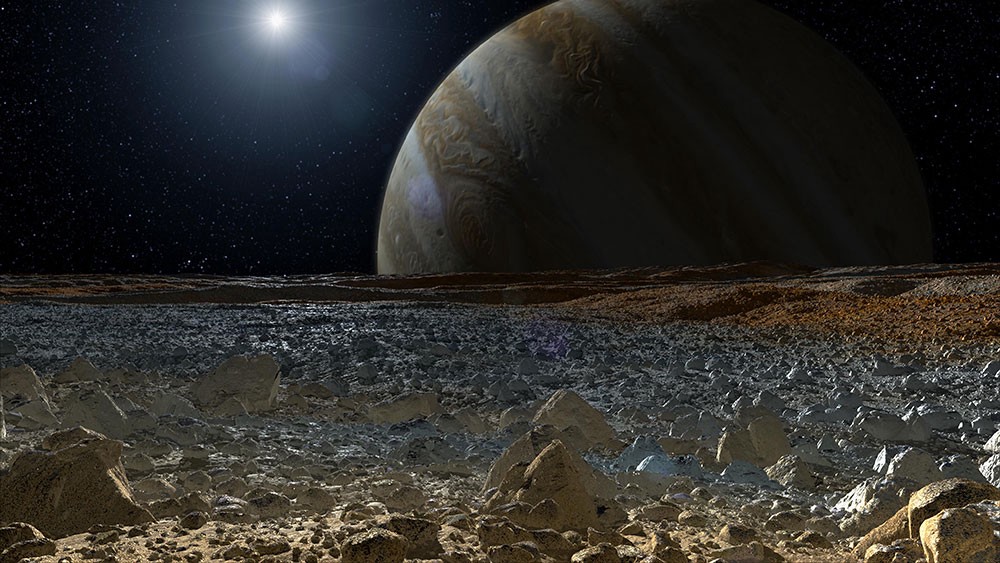 The surface of Europa with Jupiter on the horizon, seen in an artist?s concept. Image credit: NASA/JPL-Caltech
The surface of Europa with Jupiter on the horizon, seen in an artist?s concept. Image credit: NASA/JPL-Caltech
Roughly 90 percent of the size of our own Moon, Europa is home to some of the largest oceans in the Solar System. Although most of this water lies under the surface of this world, heating caused by the tidal forces of Jupiter keeps large portions of these oceans liquid, increasing chances of life evolving there.
This heating could also result in partially-frozen lakes and ponds on its surface, and plumes of water have been seen erupting 160 kilometers (100 miles) above the surface of the moon by astronomers using the Hubble Space Telescope.
The first hints of these oceans were provided in 1979, during visits by the Voyager spacecraft.
?Scientists think Europa?s ice shell is 10 to 15 miles (15 to 25 kilometers) thick, floating on an ocean 40 to 100 miles (60 to 150 kilometers) deep. So while Europa is only one-fourth the diameter of Earth, its ocean may contain twice as much water as all of Earth?s oceans combined,? NASA researchers explain in Solar System Exploration.
Like our own planet, Europa possess an iron core, rocky mantle, and salty oceans, and its icy surface could be replenished on a regular basis, as cooler, denser ice sinks, while warmer, less-dense ice rises to take its place.
Currently, NASA is planning a new mission to explore the mysteries of this mysterious moon, the Europa Clipper.
# 2: Titan
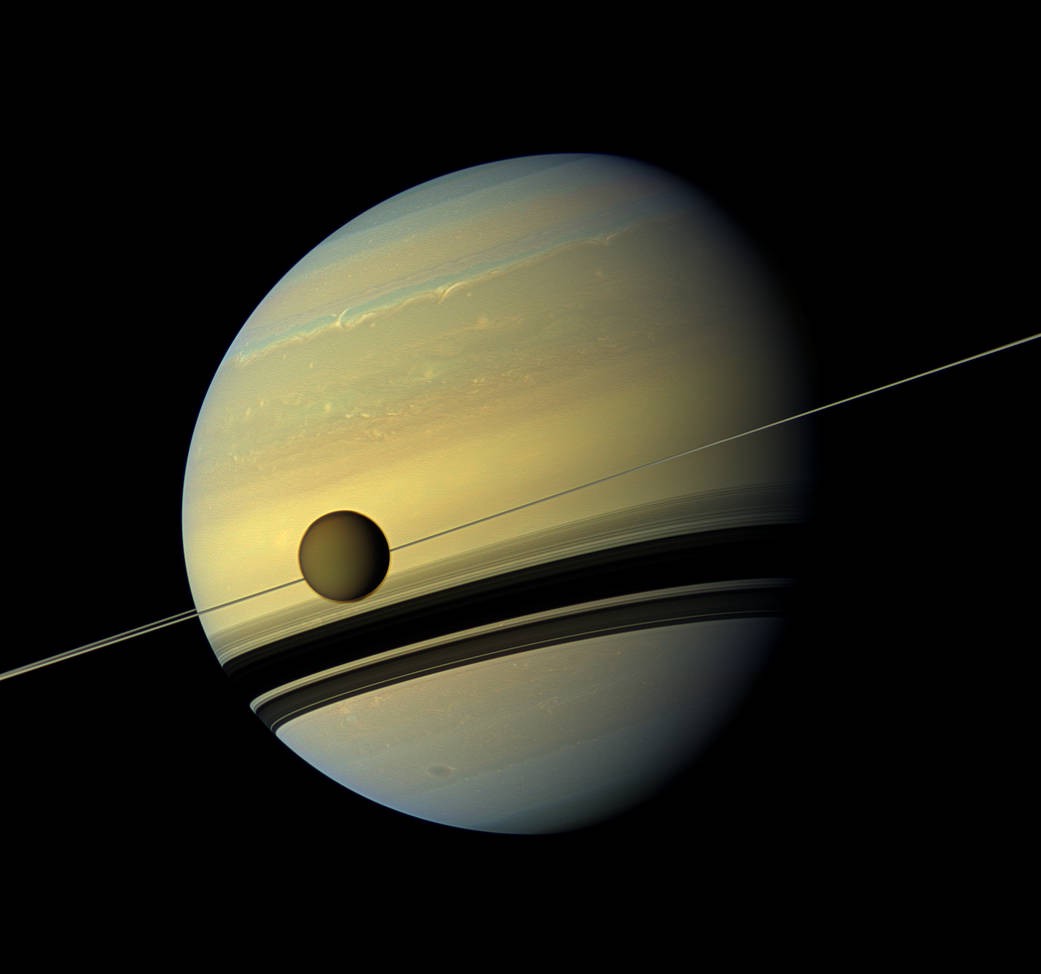 Titan seen orbiting Saturn. Large amounts of carbon and a thick atmosphere make this one of the most likely places in the Solar System to find life. Image credit: NASA/JPL-Caltech/SSI
Titan seen orbiting Saturn. Large amounts of carbon and a thick atmosphere make this one of the most likely places in the Solar System to find life. Image credit: NASA/JPL-Caltech/SSI
Titan has unique qualities for the evolution of life unseen anywhere else in the Solar System. This largest moon of Saturn is the only satellite in our family of planets known to have a substantial atmosphere. It is also the only world, other than Earth, known to have active rivers, lakes, and seas.
These seas are not composed of water, however. They are filled with methane, ethane, and other hydrocarbons. Normally, the presence of water might point to worlds likely to harbor life. However, carbon is a unique element ? it bonds to nearly anything, creating a wide variety of molecular structures. Of all the known chemical compounds, roughly half are based on carbon. It?s no surprise life on our planet is based on the same material, and active seas of organic materials make Titan a very likely place to find extraterrestrial life.
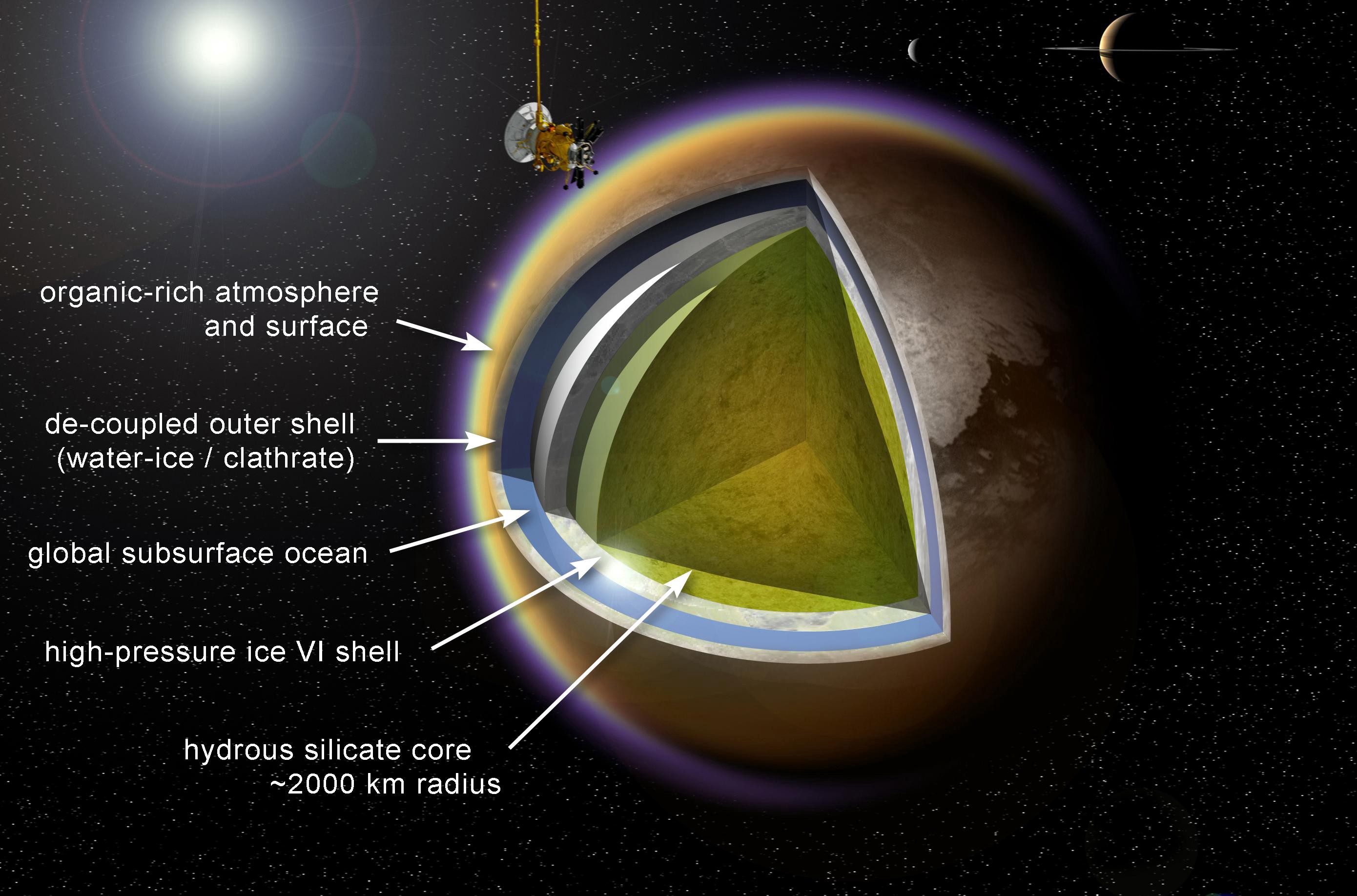 The layers of Titan come together to form a unique world. Image credit: A. D. Fortes/UCL/STFC
The layers of Titan come together to form a unique world. Image credit: A. D. Fortes/UCL/STFC
This world, larger than the planet Mercury, may also house oceans of water 55 to 80 kilometers (35 to 50 miles) beneath its surface, although this idea awaits confirmation.
Titan is a favorite locale for science-fiction writers, and it might also be one of the most likely places to find exotic lifeforms, unlike any seen on Earth.
# 3: Ganymede
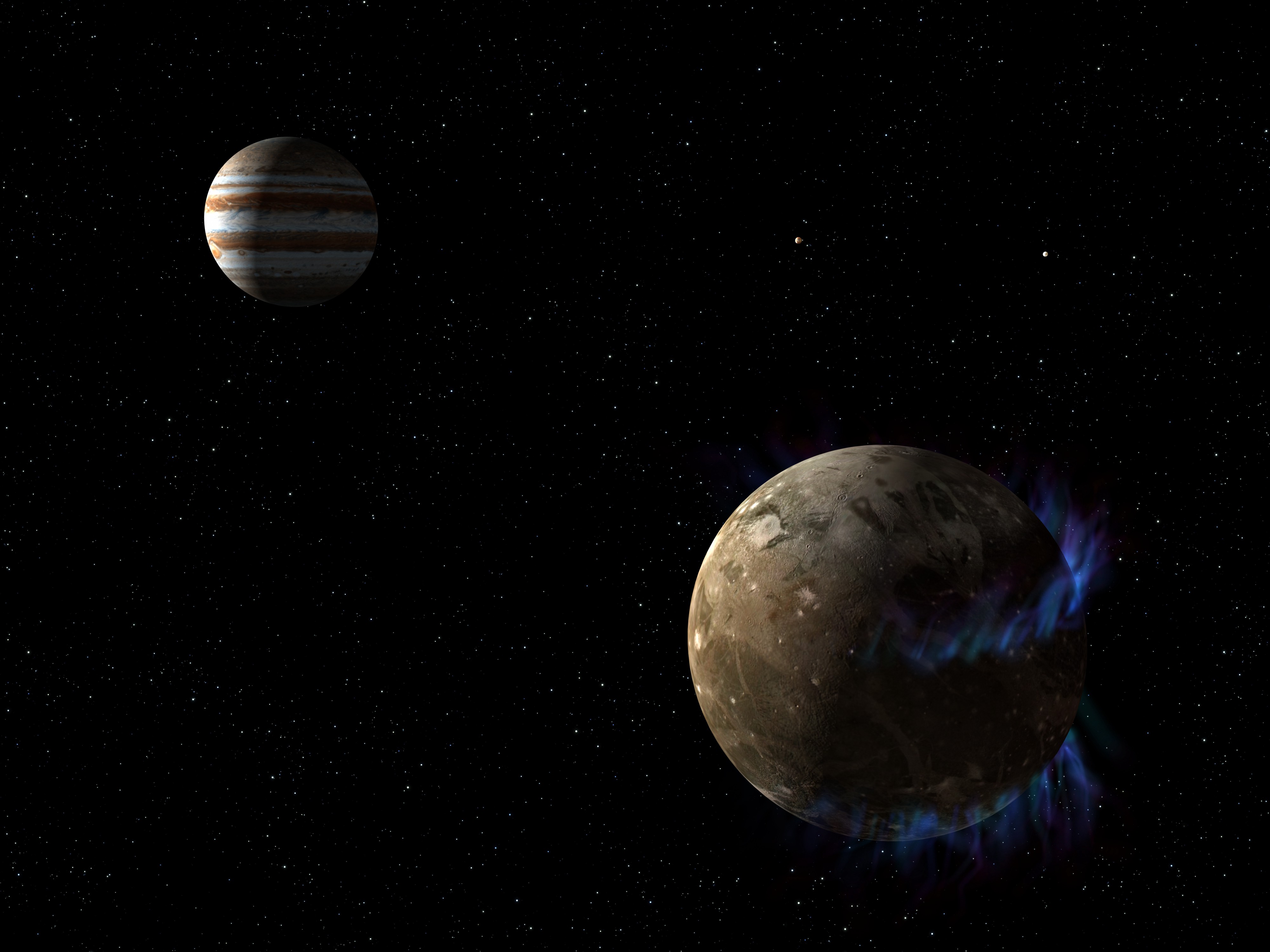 Ganymede and Jupiter, seen in an artist?s concept. Note the aurora caused by the magnetic field of the moon. Image credit: NASA
Ganymede and Jupiter, seen in an artist?s concept. Note the aurora caused by the magnetic field of the moon. Image credit: NASA
The largest moon in the solar system is also the only one to have a significant magnetic field. This is a major advantage for any life that has evolved there, as the Sun bathes the Solar System in radiation that could play havoc on lifeforms that live anywhere without such protection.
Research suggests that Ganymede could house layers of ice and liquid water between its surface and core, providing further protection for lifeforms on this massive satellite of Jupiter. The magnetic field of Ganymede also creates the only auroras known in the solar system, apart from the northern and southern lights seen on Earth.
Ganymede is composed of an iron core, surrounded by a rocky mantle, and covered in ice. Astronomers have strong evidence that a massive ocean lies under the icy crust, and tidal forces from Jupiter could keep this water in a frigid liquid form, much like a slushy from a convenience store.
Surface features on that moon show evidence of liquid rising from beneath the crust, providing further evidence of oceans of liquid water beneath the crust of this massive moon. Ganymede is larger than the planet Mercury, providing lots of space for oceans and any lifeforms which might call it home.
# 4: Ceres
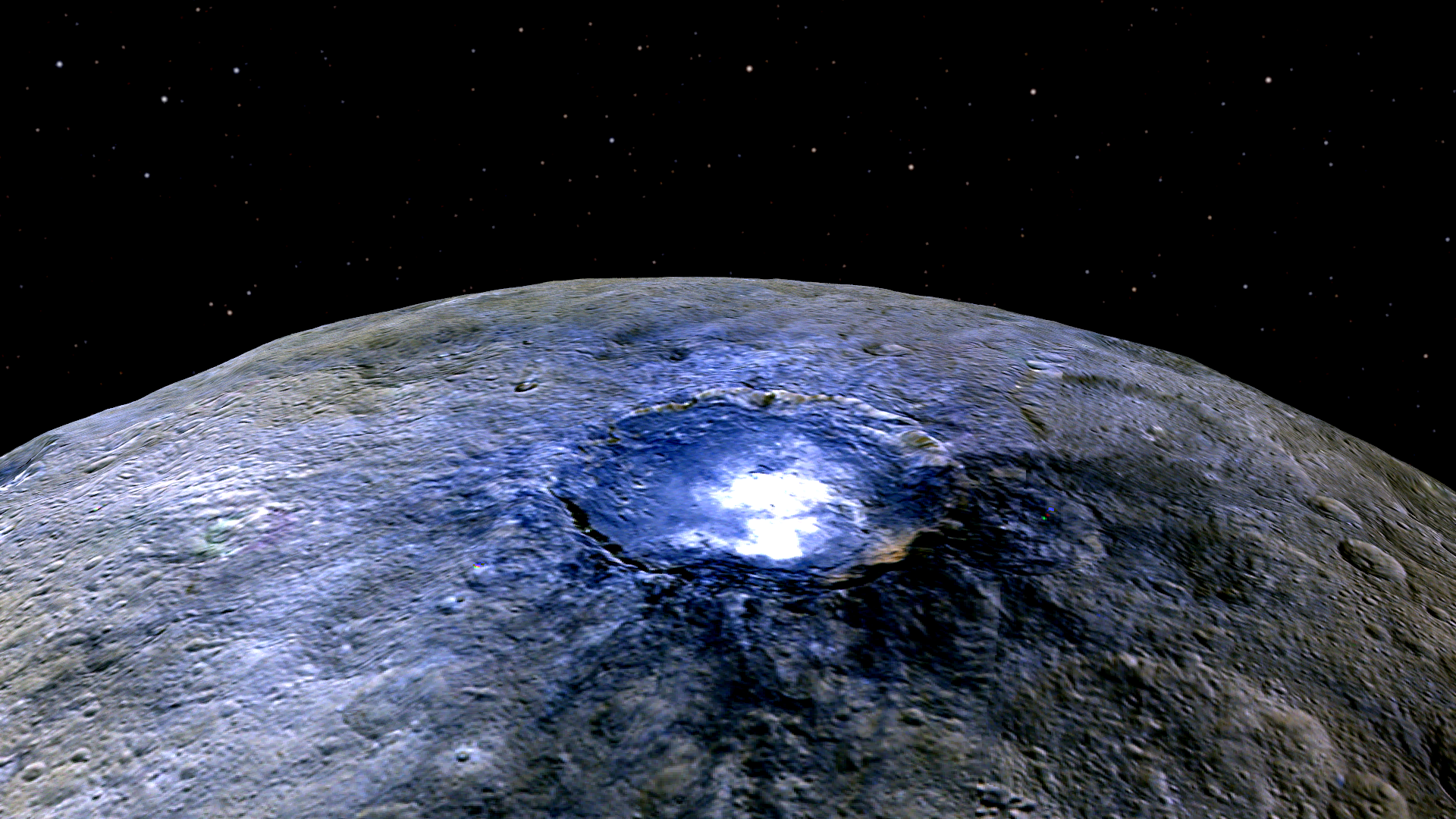 The Occator Crater on Ceres, seen in false color. Of all the dwarf planets in our solar system, this one is most likely to harbor life. Image credit: NASA/JPL-Caltech/UCLA/MPS/DLR/IDA
The Occator Crater on Ceres, seen in false color. Of all the dwarf planets in our solar system, this one is most likely to harbor life. Image credit: NASA/JPL-Caltech/UCLA/MPS/DLR/IDA
This dwarf planet is the largest member of the asteroid belt between Mars and Jupiter, and astronomers now believe the mass of this body is 25 percent water. How much of it is liquid remains a question, however. Ceres is far too small to have internal heating from its core, or to hold on to an atmosphere.
Once classified as an asteroid, this body was upgraded the class of dwarf planets in 2006, due to its significant size. Although Ceres holds one quarter of all the mass of the asteroid belt, it is still just seven percent as massive as Pluto.
Beneath its frozen crust, Ceres could house a salty ocean, where life may have once formed, and could even exist to this day. Ceres is much closer to the sun than the satellites of the outer solar system, but it does not have a companion planet to warm the world through tidal forces.
# 5: Enceladus
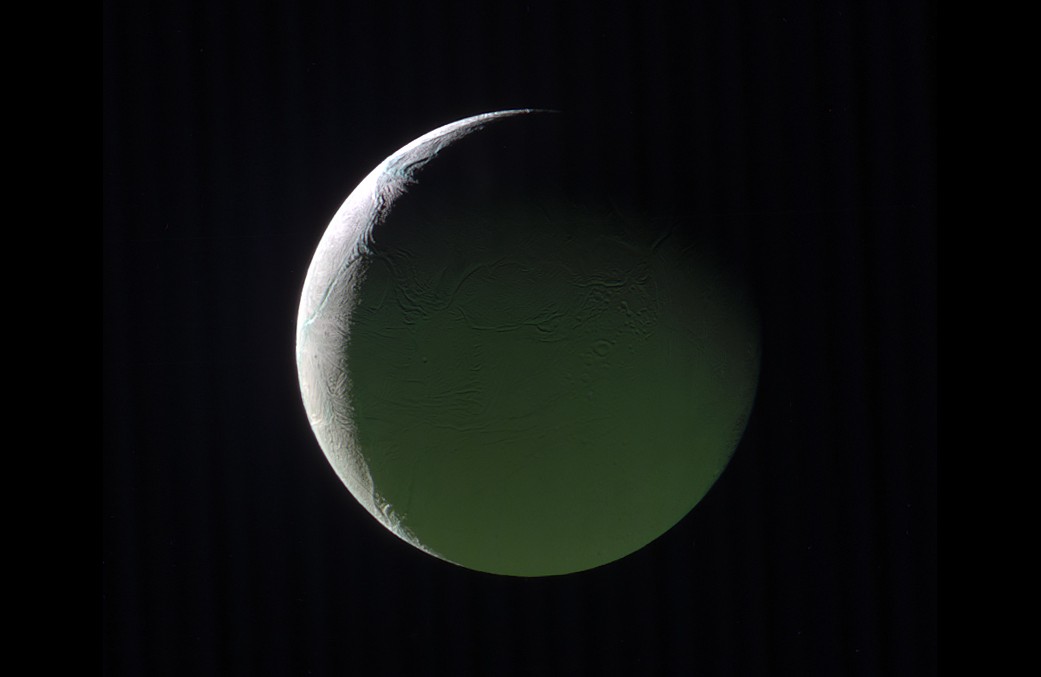 Enceladus seen in a composite image from the Cassini spacecraft. Image credit: NASA/JPL-Caltech/Space Science Institute
Enceladus seen in a composite image from the Cassini spacecraft. Image credit: NASA/JPL-Caltech/Space Science Institute
With oceans as deep as the Mariana Trench in the Pacific Ocean, Enceladus could be home to oceanic life. The highly-dynamic oceans of this tiny moon shoot water into space, forming deep fissures, called tiger strips, near the moon?s south pole. The Cassini probe which orbited Saturn exploring that world and its moons detected a form of chemical energy on Enceladus which could be consumed as food by alien life there.
?This is the closest we?ve come, so far, to identifying a place with some of the ingredients needed for a habitable environment,? said Thomas Zurbuchen, associate administrator for NASA?s Science Mission Directorate.
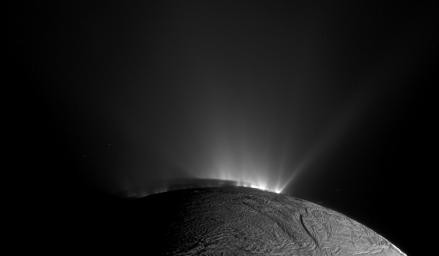 Water erupts from the surface of Enceladus. Image credit: NASA/JPL-Caltech/Space Science Institute
Water erupts from the surface of Enceladus. Image credit: NASA/JPL-Caltech/Space Science Institute
Enceladus is tiny, just over 500 kilometers (300 miles) in diameter, and it has just a small fraction of the mass of our own Moon. If Enceladus were placed on the Earth, it would barely cover the state of Arizona. Its bright white surface reflects most of the light striking it, leaving surface temperatures hovering around 200 degrees below zero Celsius (-300 Fahrenheit).
However, the ice covering the ocean of Enceladus is thin, compared to other worlds where life might exist. With its unique energy system and chemistry, this satellite is a leading candidate for places we might find life in the Solar System.
# 6: Callisto
 Callisto may not be the prettiest place in the solar system, but it is hiding a secret. Image credit: NASA/JPL/DLR
Callisto may not be the prettiest place in the solar system, but it is hiding a secret. Image credit: NASA/JPL/DLR
Known as the ?ugly duckling? of moons, Callisto may have real potential for finding life.
The second-largest moon orbiting Jupiter, its surface is the oldest and most heavily-cratered in the solar system, which would suggest little geological activity. However, the Galileo spacecraft revealed this world has a significant ocean, located 250 kilometers (155 miles) under the crust of Callisto. White dots seen on the surface of the third-largest moon in the solar system may be crater peaks covered in water ice.
Callisto also has a think atmosphere of carbon dioxide, hydrogen, and oxygen, making this moon more hospitable to living beings which may have evolved there.
# 7: Mars
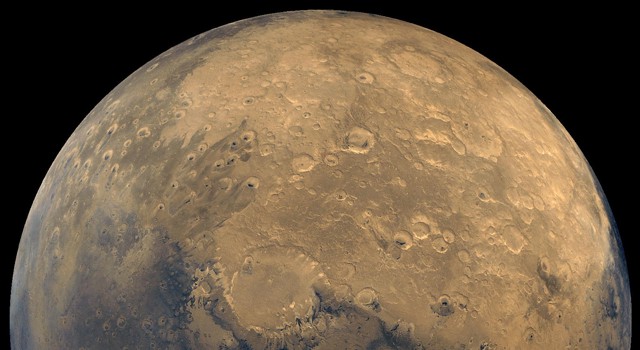 Mars, as seen in a composite image composed from 100 images recorded by the Viking landers. Image credit: NASA/JPL-Caltech/USGS
Mars, as seen in a composite image composed from 100 images recorded by the Viking landers. Image credit: NASA/JPL-Caltech/USGS
This is the world most associated with alien life, and will likely be the first to be populated by human beings, should we survive long enough, and have the willingness to migrate beyond our planetary home.
The Red Planet was once awash with water, but climatic changes billions of years ago stripped that world of liquid water and most of its atmosphere. We may find fossilized remains of ancient life there, and there is a possibility some form of life still exists within the ice hidden under its ruddy surface.
Mars is the most-explored planet in our solar system, other than the Earth. Although conditions on that world are harsh, temperatures at the equator can reach up to that experienced by people living through New England winters.
Recently, the European Space Agency named their new Mars Rover in honor of biologist Rosalind Franklin, who first determined the structure of DNA.
# 8: Triton
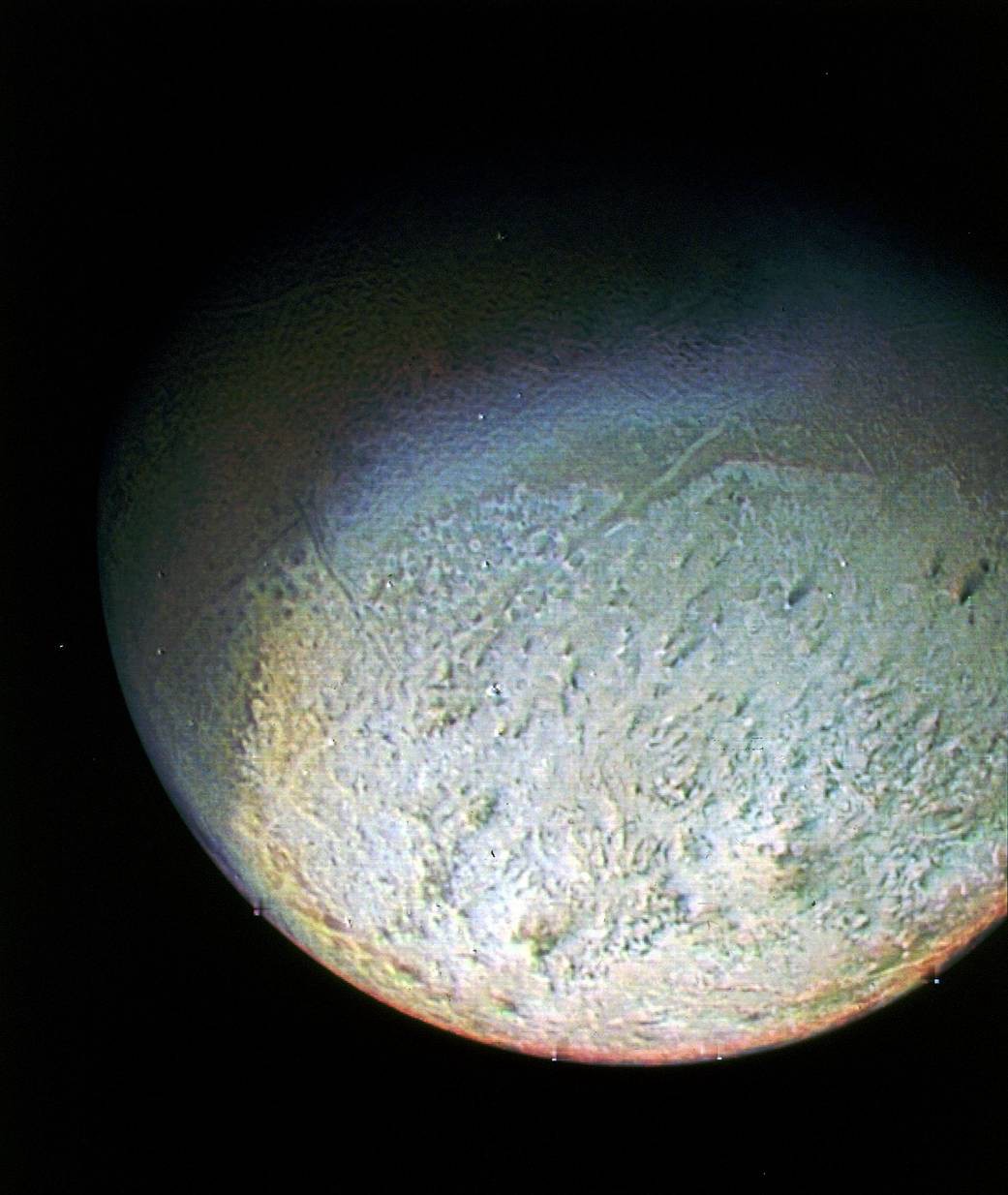 Triton in false color, seen by the Voyager 2 spacecraft in 1989. Image credit: NASA/JPL
Triton in false color, seen by the Voyager 2 spacecraft in 1989. Image credit: NASA/JPL
Currently the most-distant body in our solar system which might be home to alien life, Triton orbits the ice giant Neptune. It is still uncertain whether an ocean exists beneath its frozen crust, but cracks and volcanic features seen on this world suggest it is warmed by tidal heating from its planetary companion. Such heating might warm the oceans enough for life to form, but the chances of life here are slim, given the frigid temperatures.
Coming in at a whopping 2,700 kilometers in diameter makes Triton the largest of Neptune?s 13 known moons. Observations of this satellite show surface flows of icy lava which pour over a crust of frozen nitrogen.
Once a member of the Kuiper Belt, Triton is one of the coldest objects in the solar system, but its active geology suggest something intriguing is happening beneath its surface.
Triton remains the only body in the solar system known to have been discovered, at least in part, due to beer. This moon was discovered in 1846 by British astronomer William Lassell, using telescopes he purchased with money earned from his brewery business. If life is found there, the finding will definitely be worth a toast.
# 9: Mimas
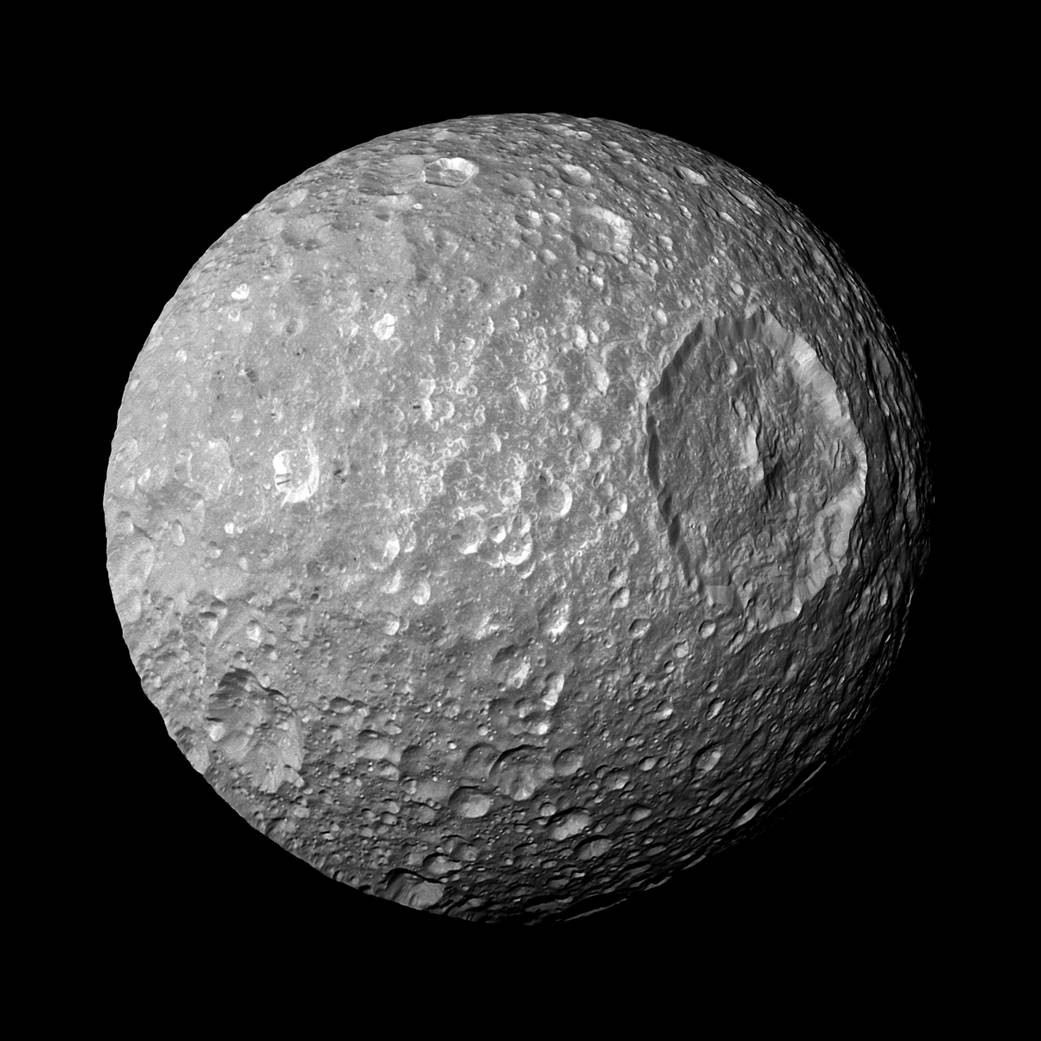 That?s no moon. That?s? Wait. It is a moon. Mimas, as seen by the Cassini spacecraft. Image credit: NASA/JPL/SSI
That?s no moon. That?s? Wait. It is a moon. Mimas, as seen by the Cassini spacecraft. Image credit: NASA/JPL/SSI
Looking like the Death Star from Star Wars, this tiny moon of Saturn may possess a subsurface ocean, located 25 to 30 kilometers (15 to 20 miles) beneath its cratered surface. However, this idea is still uncertain, and observations suggesting such an ocean could also be explained if Mimas has a football-shaped core.
Mimas is the smallest and innermost of the large moons of Saturn. However, large is relative, as this satellite is less than 200 kilometers (123 miles) from side to side. However, this tiny moon is composed entirely of ice, and although tidal forces from Saturn should warm that world enough for liquid water to be found under its surface of ice, it appears to be frozen solid, creating a conundrum for astronomers.
# 10: Pluto
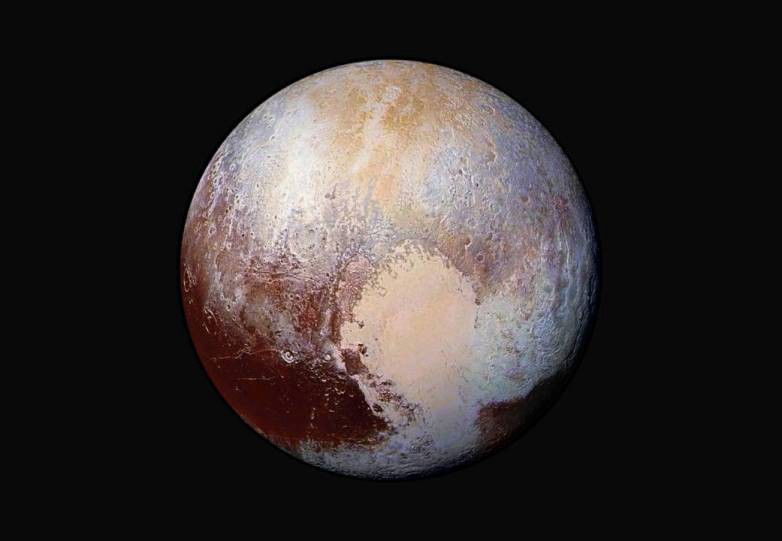 Valentine?s Day on Pluto would be quite a celebration, given the large heart. Image credit: NASA
Valentine?s Day on Pluto would be quite a celebration, given the large heart. Image credit: NASA
This is the least likely place in our solar system to find life where it might still, realistically, be found, but the possibility should not be entirely discounted. This dwarf planet, like the largest satellites of the outer solar system, could hide an ocean of water beneath its frozen surface.
Tombaugh Regio, the ?heart? of Pluto discovered by the New Horizons research team, provides clues revealing an ocean of liquid water under the surface of the dwarf planet. Studies conducted since New Horizons passed the dwarf planet show Pluto reorientated itself in a manner consistent with the presence of a sub-surface ocean.
This dwarf planet also possesses a thin atmosphere of nitrogen, methane, and carbon dioxide, which covers the world with a blue sky, featuring layers of haze.
Pluto is far too cold for life as we know it to exist, but here on Earth, we continue to find life in locations it was once thought impossible.
?To consider the Earth as the only populated world in infinite space is as absurd as to assert that in an entire field sown with millet, only one grain will grow.?
? Metrodorus of Chios,4th century BCE
If a world is active enough from a geological standpoint, distance from the Sun may be less of an issue than it would be otherwise. Here on Earth, life may have started near hydrothermal vents, where hot fluids from the core of our planet rise from the ocean floor, creating complex chemical reactions and driving heat into oceans. Similar vents are feeding hydrogen into the oceans of Enceladus.
A video explaining the role black smokers play on Earth. Credit: MARUM, University of Bremen and NOAA-Pacific Marine Environmental Laboratory
Water, once thought to be unique to Earth, is now known to sit on many worlds of our solar system, including the craters of our own Moon and Mercury. Perhaps life, currently known to exist on just our planet, will also, one day, be known on other worlds in our local family of planets.
Finding life, however primitive, on a planet or moon in our solar system would be the first sign that we are not alone in the Universe, and would change our view of the Cosmos forever.


